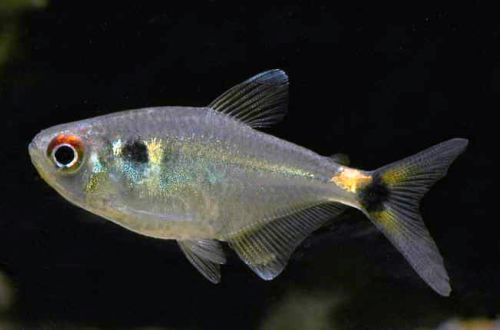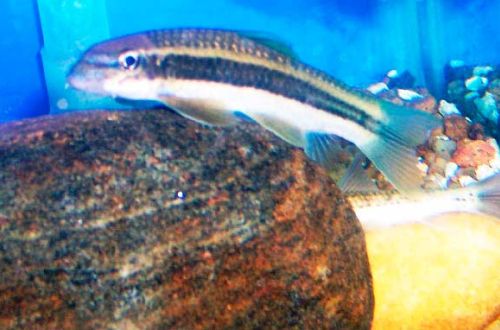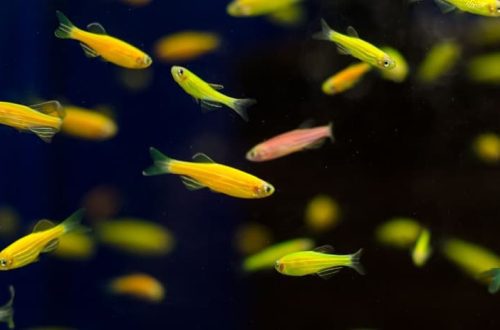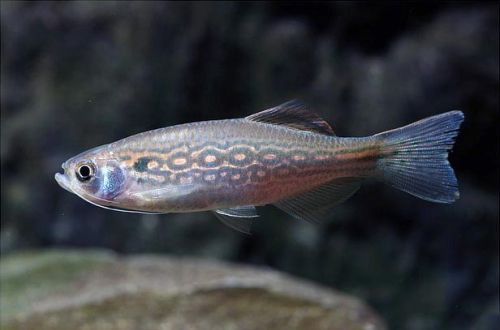
Tetra Flashlight
The flashlight or tetra flashlight, scientific name Hemigrammus ocellifer, belongs to the Characidae family. She is a popular tropical freshwater fish, easy to keep and breed, compatible with many other species of similar size. An excellent choice for the beginner aquarist.

Contents
Habitat
Widely distributed in the tropical part of the South American continent on the territory of the modern states of Guyana, Suriname, French Guiana, Peru and Brazil, they live in numerous rivers and their tributaries with a slow flow, flowing among humid rainforests.
On sale it is almost impossible to find a fish caught in the wild. Due to its popularity and unpretentiousness, it is bred commercially in large quantities, mainly in Eastern Europe.
Brief information:
- The volume of the aquarium – from 70 liters.
- Temperature – 24-28°C
- Value pH — 5.5–6.5
- Water hardness – soft to medium hard (5-20 dGH)
- Substrate type – any sandy
- Lighting – subdued
- Brackish water – no
- Water movement is weak
- The size of the fish is about 4.5 cm.
- Food – any food
- Temperament – peaceful
- Keeping in a flock of at least 6-10 individuals
Description
Adult individuals reach a length of no more than 4.5 cm. The color of the body is silver with translucent fins. A distinctive feature that gave the name to this species is the presence of red pigment in the upper region of the eye. A light yellow stripe is barely visible, stretching along the lateral line, which is limited by large dark spots. The first is located immediately behind the gill cover, the second at the base of the tail. Sexual dimorphism is weakly expressed, females are often slightly larger than males with a more rounded abdomen.
A close relative of the Flashlight Tetra, Pulcher, demonstrates a similar coloration. They have a lot in common and are often confused.
Food
Because the Flashlight Tetra has been bred for many generations in the artificial environment of aquariums, it is perfectly adapted to any dry industrial food (flakes, granules, etc.).
As a recommendation, to maintain the tone of the fish, a combination of a variety of foods should be served with the inclusion of live or frozen foods, such as bloodworms, daphnia and brine shrimp.
Maintenance and care, arrangement of the aquarium
An exceptionally unpretentious fish that can feel great even in Spartan conditions. However, it is still worth creating a comfortable environment for your pets. Namely, to prepare a tank with a volume of 70 liters or more, in the design of which a sandy river substrate, a certain amount of snags (natural or decorative) and a group of rooting and floating plants are used. Aquarium equipment is set up in such a way that the lighting fixtures give a subdued light, and the working filters do not cause a strong current.
Water conditions are characterized by a slightly acidic pH with low to medium hardness, with a temperature range of 24–28°C.
Maintenance is reduced to a weekly replacement of part of the water (10-15% of the volume) with fresh and regular cleaning of the soil from organic waste, and glass from plaque.
Behavior and Compatibility
One of the best candidates for a general aquarium, goes well with other peaceful fish of a similar size, such as viviparous species, zebrafish, rasboras, tetras, corydoras catfish, etc. Obviously, due to the small size of the Tetra-flashlight, sharing with large fish can be dangerous for her.
Keeping exclusively in a flock of at least 6 individuals, in this case, be guided by the principle – the more, the better.
Breeding / breeding
At home, it will not be difficult to get offspring, the fish will breed even in a common aquarium, but in this case the survival rate of the fry will be extremely small. They will become a victim not only of their neighbors in the aquarium, but also of their own parents.
If you are planning to start breeding, you should purchase a separate tank with a volume of about 20-30 liters, you can meze the design, the main thing is to prepare several dense small-leaved plants or mosses that will protect the eggs from being eaten. The same purpose is served by a mesh in a small cell located at the bottom, or a layer of glass beads. Of the equipment, a simple sponge airlift filter and a heater are sufficient. The lighting system can be neglected, the light coming from the room will be more than enough.
Spawning is stimulated by a gradual change in water conditions until the pH values are set at around 5.5–6.5 at low carbonate hardness (dH 1–5). The temperature rises to 28°C. The daily diet includes a large amount of live food.
After a while, the females become noticeably rounder, this will mean the approach of the mating season. Females and the strongest males are transplanted into a separate tank, which is filled with water from a common aquarium. At the end of spawning, the fish are returned back. The fry appear within 24-36 hours, and after another 3-4 days they begin to swim freely, from this moment it is necessary to start feeding them with specialized food for juvenile aquarium fish.
Fish diseases
A balanced aquarium system with the right conditions is the best guarantee against any disease in the Flashlight Tetra. Therefore, if the behavior of the fish has changed, the color has changed, non-characteristic spots have appeared, and so on, first check the water parameters, and only then proceed to treatment.





